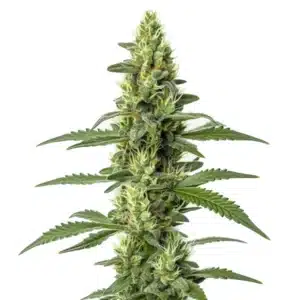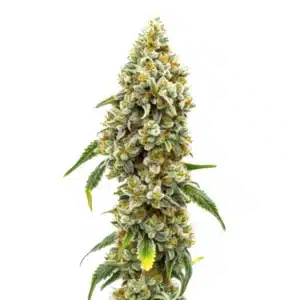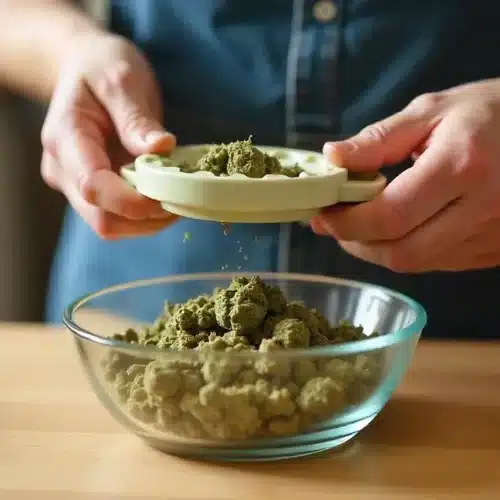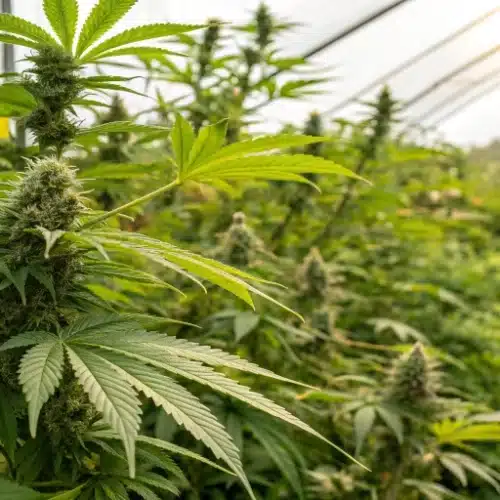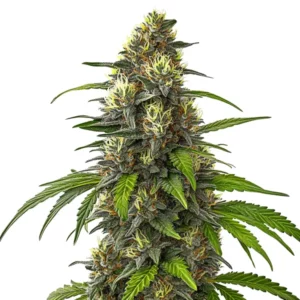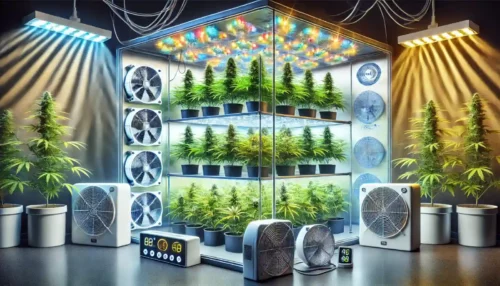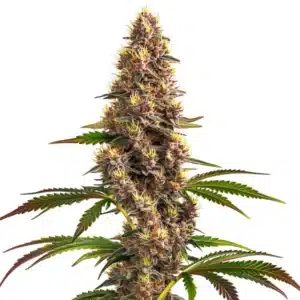Germination and Seedling Stage
When embarking on the journey of cultivating cannabis, the first step is germination. This critical phase kicks off the cannabis lifecycle, setting the stage for healthy growth. For anyone wondering how long does it take to grow cannabis indoors, it all begins here with germination typically taking about 2 to 7 days. However, in some exceptional cases, a seed may take up to 15 days to sprout. If it hasn’t germinated, gently pressing it between your fingers can help you determine whether it’s still viable (firm) or dead (cracked or mushy).
Once the seeds are planted in a suitable medium, they need warmth and moisture to awaken from their dormant state. It’s important not to plant the taproot too deep or upside down, as doing so can delay emergence. Always ensure it’s positioned root-tip down and shallow enough to allow easy breakout.
During this stage, you will observe the emergence of a small taproot, which is a sign that your seeds are on their way to becoming strong plants. It’s essential to create an optimal environment for these delicate seedlings. A temperature range of 70-80°F (21-27°C) and a humidity level of around 70% can significantly enhance germination success. Soil texture also matters if the substrate is soft and loose, the roots will develop more easily, speeding up seedling emergence and growth. Once the taproot is visible, it’s time to transfer the seedlings into their growing medium.
How Long Does it Take to Grow Cannabis Indoors: Duration and Key Signs
As your seedlings start to grow, you will notice the first set of true leaves, called cotyledons, emerging. These leaves are typically round and differ from the serrated leaves that will develop later. This stage can last anywhere from 1 to 3 weeks. The root system plays a central role in growth speed plants with ample space to develop roots will mature more quickly.
During this period, nurturing your seedlings with adequate light (18-24 hours daily) and maintaining humidity levels will ensure they thrive. It’s crucial to monitor them closely, as any signs of stress can delay growth and development. Additionally, early mistakes such as poor watering or inadequate nutrients can push back your expected harvest timeline. Every error in these early stages whether it’s underfeeding, pest infestation, or drought stress costs time later on.
In this initial stage, you may also encounter some common issues such as overwatering or nutrient deficiencies. Addressing these promptly will prevent stunted growth and help your plants transition smoothly into the vegetative phase. Ensure that the seedlings are watered sparingly and that the growing medium provides adequate drainage. By recognizing these key signs, you’ll be on your way to developing robust plants ready for the next stage of growth.
Promos & Deals
Vegetative Phase
Following the seedling stage, cannabis plants enter the vegetative phase, where growth truly accelerates. This phase can last anywhere from 3 to 16 weeks, depending on the desired plant size and strain. In general, a plant becomes mature enough to show sex or initiate flowering between 21 and 30 days into this phase. If you’re working with photoperiod plants, that’s when you can flip them to flower autoflowers will begin on their own once mature.
Light is one of the most critical factors during this stage. Cannabis plants thrive under 18-24 hours of light per day. Using high-quality grow lights can significantly enhance growth speed. Ventilation also plays a surprisingly powerful role here good airflow not only strengthens stems but also speeds up development by improving gas exchange and oxygen availability at the root zone.
Regular watering, proper nutrient dosing, and maintaining optimal temperature and humidity levels are vital. The healthier the root zone and canopy, the faster your plants will move toward flowering.
Growth Speed and Factors
Several factors influence how quickly your cannabis plants will grow during the vegetative phase. Genetics play a significant role, as some strains are naturally more vigorous than others. Environmental conditions such as temperature, humidity, and light intensity also contribute to how long this phase lasts. For instance, maintaining a temperature of around 70-85°F (21-29°C) and a humidity level of 40-60% creates ideal conditions.
Interestingly, if your grow environment is dialed in ideal light spectrum, stable temperature, humidity, and CO₂ enrichment plants often mature slightly earlier than the timelines provided by seed banks. This is especially true with well-managed indoor grows using CO₂ supplementation, which can shorten flowering time and improve final yields.
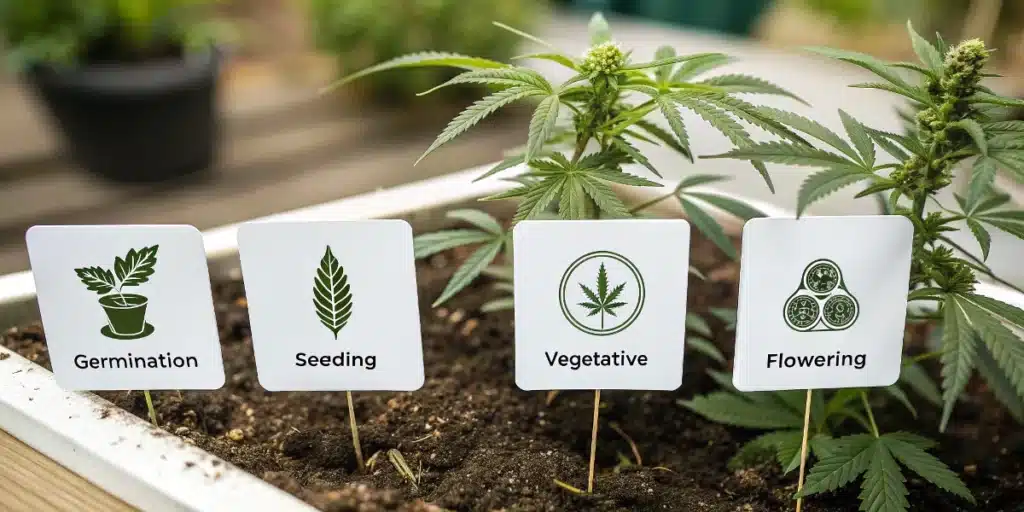
Flowering and Harvest
Once your cannabis plants have reached the desired size during the vegetative stage, it’s time to guide them into the flowering phase. This stage marks a significant shift in the plant’s development, where the focus moves from leaf and stem growth to bud production. The decision on when to plant cannabis earlier in the season directly affects how well this stage unfolds, especially for outdoor grows where natural light patterns dictate the plant’s rhythm. For indoor growers wondering how long does it take to grow cannabis indoors, it’s essential to monitor your plants closely and ensure they are mature and healthy enough before initiating this transition.
The flowering stage typically lasts between 6 to 12 weeks, although this can vary greatly depending on the strain. Indicas usually flower quicker, often finishing in 6 to 8 weeks, while sativas may take 10 weeks or more. Hybrid strains often fall somewhere in between. To trigger flowering indoors, the light cycle should be switched to 12 hours of light and 12 hours of complete darkness. This mimics the natural shortening of days that occurs in late summer and signals to the plant that it’s time to begin reproductive growth. If you’re growing outdoors, the natural seasonal shift will take care of this change, which is why knowing when to plant cannabis is so vital for maximizing yield and ensuring timely harvests.
A good tip for harvest timing: wait until 90% of the pistils on the buds have turned dark orange. This is a reliable sign that your flowers have reached peak maturity in terms of potency and terpene development.
During this period, your plants will develop pistils (white hairs) and trichomes (resin glands). It’s essential to maintain good air circulation and a steady environment. Every stressor whether it’s overfeeding, poor airflow, or pest outbreaks can delay flowering and reduce yield. Time lost during flowering is difficult to recover.
How Long Does it Take to Grow Cannabis Indoors: Indicators and Timelines
As the flowering phase progresses, keep an eye on key indicators to determine when your plants are ready for harvest. The pistils, or hairs, on the buds will change color from white to amber, signaling ripeness. Additionally, trichomes, the tiny resinous glands on the buds, will change from clear to milky white, indicating peak potency. This stage can last from 6 to 12 weeks, so patience is necessary as you monitor these signs closely.
Harvesting at the right time is crucial for achieving the desired effects of your cannabis. Cutting your plants too early can lead to lower potency and yield, while waiting too long can result in overripe buds with diminished effects. It’s a delicate balance, but with careful observation, you can master the timing and enjoy a bountiful harvest.
Overall Timeline Summary
Knowinghow long does it take to grow cannabis indoors involves recognizing the stages and their timeframes. From germination and seedling to vegetative and flowering, the full cycle typically takes 3 to 6 months, depending on strain, growing conditions, and grower skill.
Here’s a breakdown:
- Germination: 2 to 15 days (under ideal conditions, 2–7 days)
- Seedling Stage: 1 to 3 weeks
- Vegetative Phase: 3 to 16 weeks
- Flowering Phase: 6 to 12 weeks
Every growing error such as incorrect light distance, pH imbalance, poor nutrition, or insufficient airflow adds days or even weeks to your timeline.
How Long Does it Take to Grow Cannabis Indoors: Tips for Efficiency
To maximize your efficiency and ensure a smoother growing experience, consider implementing a few key strategies. Start by investing in quality seeds and maintaining a clean growing environment to reduce the risk of pests and diseases. Properly calibrate your lights and nutrients according to the specific needs of your cannabis strain. Regularly check on your plants, adjusting environmental conditions as necessary to promote optimal growth.
Another effective tip is to document your growing process. Keeping track of your plants’ progress, including growth rates, nutrient schedules, and any challenges encountered, will help you refine your techniques for future grows. By learning from each cycle, you’ll become more adept at cultivating cannabis indoors, ultimately shortening your timeline and improving overall yields.
To speed up the process (without compromising quality), consider these expert-backed tips:
- Start with loose, airy soil to encourage root development.
- Keep CO₂ levels elevated during flowering to accelerate bud formation.
- Use strong but well-distributed airflow to improve stem strength and metabolic speed.
- Log your grow cycles in a notebook or app this allows you to correct errors early.
- Choose fast-flowering or autoflower strains if time is a major constraint.
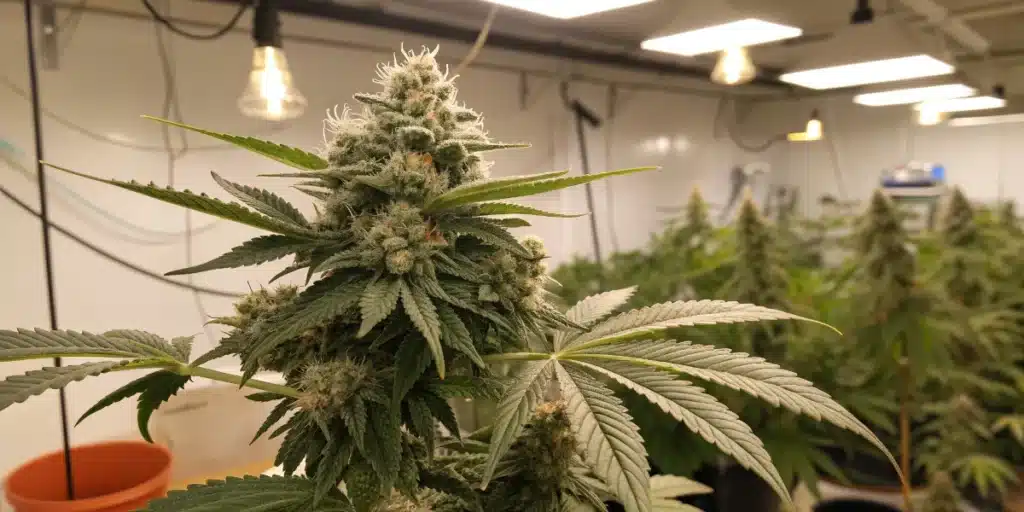
FAQS
How often should I water my cannabis plants during the growing stages?
Watering frequency can vary based on several factors, including plant size, growing medium, and environmental conditions. As a rule of thumb, it’s best to allow the top inch of soil to dry out before watering again. This ensures that the roots receive adequate moisture without becoming waterlogged.
What is the ideal temperature and humidity for growing cannabis indoors?
The ideal temperature for indoor cannabis growth is typically between 70-85°F (21-29°C) during the day and slightly cooler at night. Humidity levels should be around 40-60% during the vegetative phase, decreasing to 30-50% during the flowering phase to prevent mold and mildew.
Can I speed up the cannabis growing timeline?
While you can optimize conditions to promote faster growth, it’s essential to avoid rushing your plants through their natural lifecycle. Providing adequate light, nutrients, and a stable environment can help maximize growth rates, but each stage must be allowed to complete its natural process for the best results.



